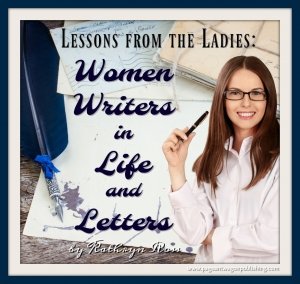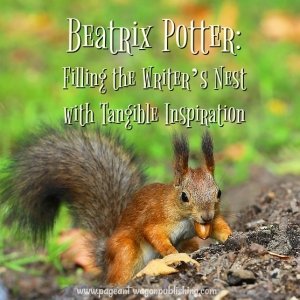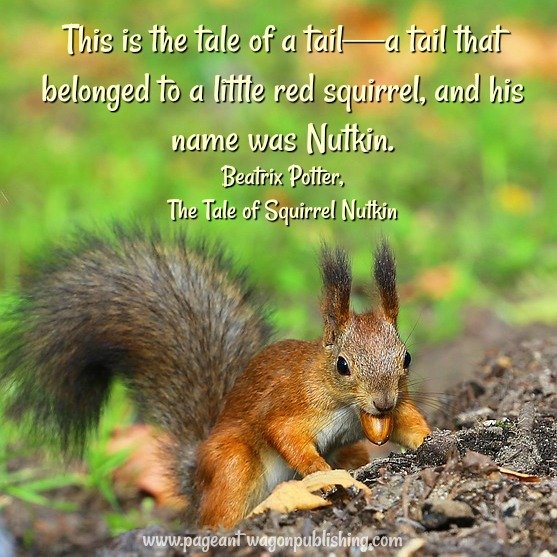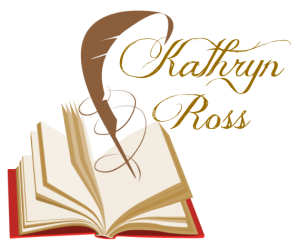
Read this installment from my series,Women Writers in Life and Letters at Almost An Author for October 2018. Check out the whole series plus a host of excellent articles to help you become a strong writer and Christian communicator.
This is the tale of a tail—a tail that belonged to a little red squirrel, and his name was Nutkin.
Beatrix Potter, 1903
The Tale of Squirrel Nutkin
There’s something cleansing about the opening line of a Beatrix Potter storybook. I can almost hear her reading it in a sing-song voice, with just a touch of playfulness and sufficient drama to embolden the cautionary lesson at the climax of each tale. The solid, moral footing of her stories drawn from her keen, life-long observation of the flora and fauna in the Lake District of England, grounds whimsy in a swath of reality. I recommend hoarding a nest full of her nutritious tales for children of all ages, living in any era, as part of a Family Literary Lifestyle.

Miss Potter’s legacy of little animals going about the daily chores of farm and village life, wearing clothing and sipping tea in blissful existence next to humans, developed from the seed of her childhood. Growing up in a well-to-do home in London, her Victorian parents, as was the fashion of the day, had little interaction with Beatrix and her brother, Bertram, in their early years. On occasion, Beatrix’s father, connected with some of the trendy artists of the late 1800s, took her with him to art galleries and museums, feeding her desire to develop her own artistic skills.
Sketches from her childhood journals reveal a natural talent, blossoming with many hours of solitude in her third-floor nursery to perfect precise lines and watercolor techniques. When living in London, Beatrix completed her academic assignments under the tutelage of a nurse, and then governess. They, along with the servants in the house—cook and butler—encouraged her fascination with life in the garden. Though Beatrix might be tasked with finishing a still life drawing for a lesson, her favorite art subjects scampered, scurried, and skittered about on four legs between bushes, along fences, and up tree trunks out of doors.
In the late spring each year, the family moved to a fine summer home in the Lake District area until early fall when they returned for “the season” to London. In the glories of the English countryside, Beatrix roamed meadows and woodlands searching out all manner of plants and creatures in their burrows. She kept a journal of their habits and personality sketches, as well as detailed drawings of them in varied poses and settings. Then, of course, she’d name them. And some she’d adopt, making for quite a menagerie of cages and wicker boxes in her rooms.
Her furry roommates became famous as lead characters in her stories including Peter Rabbit, Benjamin Bunny, Hunca Munca mouse, and more—like Squirrel Nutkin.

I usually like to bring out all my Beatrix Potter collection of books and figurines for springtime décor. But in the fall, I always display The Tale of Squirrel Nutkin, one of my favorites. I love the Autumn shades of reds, golds, and browns in the art, and how delightfully she captures the seasonal escapades of squirrels, gathering nuts and hoarding them to feed off of through the winter under the lordly gaze of Old Brown, the owl.
My front and back gardens are full of squirrels at present, continuing in the ritual, unmoved by world changes over the last 100 years. The constancy of their lifestyle acts as a compass for me, grounding me in how I see life and cherish what matters. Their quirk-some personalities delight as much as they chide my heart, as I see myself in some of their habits. Beatrix might have mused in the same way, studying her squirrel friends. She used her observations to great success in speaking bold commentary on the human heart through country landscapes and the antics of the creatures who live there.
One of the things that I believe fed her tales and ability to pepper her character sketches with engaging detail, was the fact that she surrounded her world—be it her room, gardens, or hours in a meadow—with tangible inspiration. She lived among physical displays of the subjects in her art and writing. Squirrels and owls—she knew them intimately because she had them close at hand, living as pets in her room, to observe and manifest in The Tale of Squirrel Nutkin.
Tangible inspiration.
I regularly make use of this writing technique—though not in the collecting of small animals from the wild. I’m a visual learner and creator. I can’t write in a sparsely appointed room because I’m constantly distracted by bare walls, thinking what I might want to put there to fill the space. This translates to my writing life in the habit of surrounding myself with physical objects to inspire whatever it is I’m writing about.
For instance, some years ago I ran a theatrical group and regularly wrote and produced plays for performance. I’d spend a year collecting props and costumes, slowly positioning them in my living room. Displayed for me in daily view, I meditated on the story they might help me tell, and how I might use them in the script. Keeping objects visually before me fed inspiration within and allowed my brain to drift to the land of “What If,” allowing imagination full sway, until words bubbled forth.
As both illustrator and writer, Beatrix Potter’s work testifies to this visual learning style technique, further inspiring me as a writer and storyteller. In fact, when I speak, I rarely do so behind a simple podium. There must be a stage and setting. Props and tangible visuals. I rely more on these items surrounding me on a platform than I do on written notes. And I, like Beatrix, prove that a picture—tangible inspiration—is worth a thousand words. The writer just needs to mine those words. Then click publish.
Journal Prompt: How do you surround yourself with inspiration to write? Think about a time when a physical object or tangible inspiration was the seedbed and soil to your written work.
Bonus Writing Exercise: Choose a smattering of objects unrelated to each other and arrange them in a display. Study them and begin to cast them as characters, setting, and conflict in a short story of your own. How does writing with physical objects as your inspiration make a difference to how your story unfolds?
TWEET: [bctt tweet="#BeatrixPotter and a Gathering of Nuts—filling your writing nest with inspiration to feed upon; Women Writers in Life and Letters Series @A3writers @misskathypwp" username="misskathypwp"]
TWEET: [bctt tweet="#Women Writers in Life and Letters—Beatrix Potter: Filling the Writer’s Nest with Tangible Inspiration @A3writers @misskathypwp" via="no"]

Posted from my blog with SteemPress : https://pageantwagonpublishing.com/beatrix-potter-tangible-inspirations/
Hi! I am a robot. I just upvoted you! I found similar content that readers might be interested in:
https://www.almostanauthor.com/beatrix-potter-filling-the-writers-nest-with-tangible-inspiration/
Downvoting a post can decrease pending rewards and make it less visible. Common reasons:
Submit